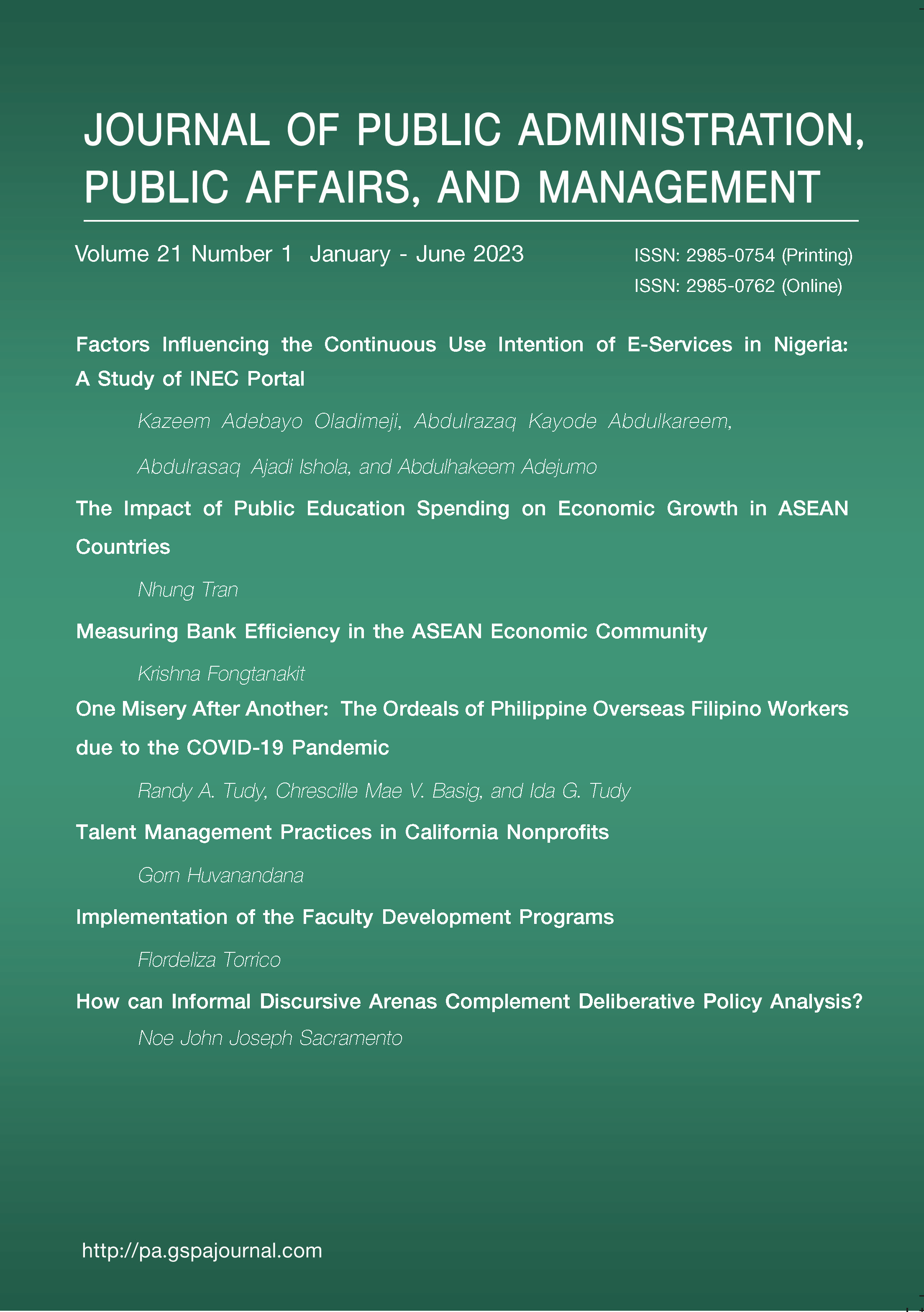Implementation of the Faculty Development Programs
คำสำคัญ:
Faculty development program, implementation, facultyบทคัดย่อ
This study determines the level of implementation of the Faculty Development Programs in Surigao del Sur State University. Specifically, it sought to answer the following questions: What is the profile of the respondents in terms of: Age, Position/Academic Rank, Campus, Years in Service, Highest Educational Attainment and Status of Appointment; What is the level of implementation of the Faculty Development Programs in Surigao del Sur State University (SDSSU). It is perceived by the faculty in terms of: The Modified Non-Inbreeding Faculty Development Program, Lateral Entry, Research and Development, Community Services and Extension, Industry Immersion, Local and Foreign Exchange, Continuing Professional Development, Assistance for Thesis and Dissertation and Short-term Training abroad; Is there a significant difference in the perception of the faculty as to the level of implementation of faculty development programs when grouped by campus?; What are the challenges met in the implementation of faculty development programs of SDSSU as perceived by the faculty?; Is there a significant difference in the challenges met in the implementation of faculty development programs as perceived by the faculty when grouped by campus?; Is there a significant relationship between the profile of the respondents and the level of implementation of the faculty development programs?; Is there a significant relationship between the profile of the respondents and the challenges met during the implementation of the faculty development programs? And What intervention program can be proposed based on the findings of the study? The respondents are the one hundred sixty-nine faculty holding the permanent and temporary permanent positions of SDSSU. A validated questionnaire served as the instrument of the study wherein the researcher itself personally conducted the study to the six campuses of the university during the academic year 2018-2019.
The findings of the entire study revealed that 34 percent of the respondents are in the ages of 31 to 40 years old while 31 percent are 20 to 30 years old. Sixty-four percent (64 percent) of them are Instructor 1-3 while only 2 percent belonged to Professor 1-6. As to the educational attainment, 42 percent of the respondents are Master’s degree while 17 percent were enrolled in doctorate subjects. 63 percent of them were in 1-10 years of stay in the university as a permanent employee of the university. As to the implementation of the Faculty Development Programs, respondents perceived that the Modified Non-inbreeding Policy, Research and Development, Community Services and Extension, Industry Immersion and Continuing Professional Development Programs as Frequently Implemented with the total mean of 3.46. Lateral Entry Program rated as Implemented by the respondents with a total of 3.24 while the Development Programs implemented the Local and Foreign Exchange Program moderately. With regards to the challenges met by the respondents in the implementation of the Faculty Development Programs, respondents admitted that they experienced stress due to overloaded designations, uncomfortable work environment and personality differences among faculty some of the time.
It is concluded that most of the respondents are able to handle and care all the academic matters of the students since they were ahead as to age and experience in life. They belong to the lowest rank in academe since most of them are still in the entry level positions. They are academically advanced and competitive to their specific field of disciplines, long years of experience in teaching and productive in work since they are stable and eligible to receive the different benefits coming from the National Government. Also, it manifested the Faculty Development Programs such as Modified Non-inbreeding Policy, Research and Development, Community Services and Extension, Industry Immersion and Continuing Professional Development Programs to the six campuses. Thus, respondents were able to enjoy and experience the benefits offered of the said FDPs such as they were sent to advance training and education to other institutions to gain insights and learnings, build strong linkages with the stakeholders, etc. Only that the Local and Foreign exchange program should be given attention by the administration to improve and made known to the faculty the kind of program. Lastly, respondents felt burdened and uneasy to work since they were loaded with responsibilities and works to accomplish aside from teaching the students. The program designated them with the positions that pressured them in beating the deadlines on reports and accomplishments. Lacking classrooms also to cater the total students of the university contributed to them being uncomfortable and dissatisfied in work setting.
เอกสารอ้างอิง
Bilal, Guraya, S. Y., & Chen, S. (2019). The impact and effectiveness of faculty development program in fostering the faculty’s knowledge, skills, and professional competence: A systematic review and meta-analysis. Saudi Journal of Biological Sciences, 26(4), 688–697.
Congress of the Philippines. (2009). Republic Act No. 9998. Retrieved from https://lawphil.net/statutes/repacts/ra2010/ra_9998_2010.html.
Clayton, M. (2016). Rensis Likert: Participative management. Management Pocketbooks. Retrieved from https://www.pocketbook.co.uk/blog/2016/11/08/rensis-likert-participative-management/
Dininni, J. (2017). Human Relations Management Theory. Retrieved from https://www.business.com/articles/human-relations-management-theory/july/2017/.
Hopkins, W. G. (2000). Research designs: Choosing and fine-tuning a design for your study. SportScience, 4(1).
Koh, E. T., & Owen, W. L. (2000). Descriptive research and qualitative research. In Koh, E. T., & Owen W. L., Introduction to Nutrition and Health Research. Springer
Kuijk, A. (2018). Herzberg Two Factor Theory of Motivation. Toolshero. Retrieved from https://www.toolshero.com/psychology/two-factor-theory-herzberg/.
Mulder, P. (2017). Human Relations Theory of Management by Elton Mayo. Toolshero. Retrieved from https://www.toolshero.com/management/human-relations-theory/.
Prachyapruit, A. (2001). Socialization of new faculty at a public university in Thailand. Unpublished doctoral dissertation, Michigan State University.
Schmitz, C. C. (2000). Evaluation of the “Learning by Doing” Faculty Development Program for the Minnesota State Colleges and Universities (MnSCU) Center for Teaching and Learning. Final Report Summary. MnSCU Bush Foundation.
Watson, D. (2000). Emotions and Social Behavior. Mood and Temperament. Guilford Press.
ดาวน์โหลด
เผยแพร่แล้ว
ฉบับ
ประเภทบทความ
สัญญาอนุญาต

อนุญาตภายใต้เงื่อนไข Creative Commons Attribution-NonCommercial-NoDerivatives 4.0 International License.



